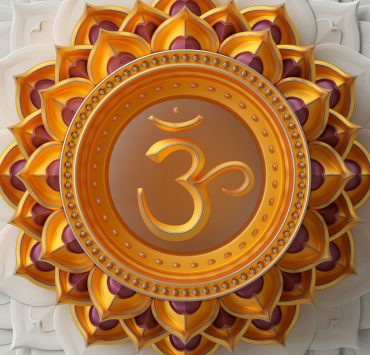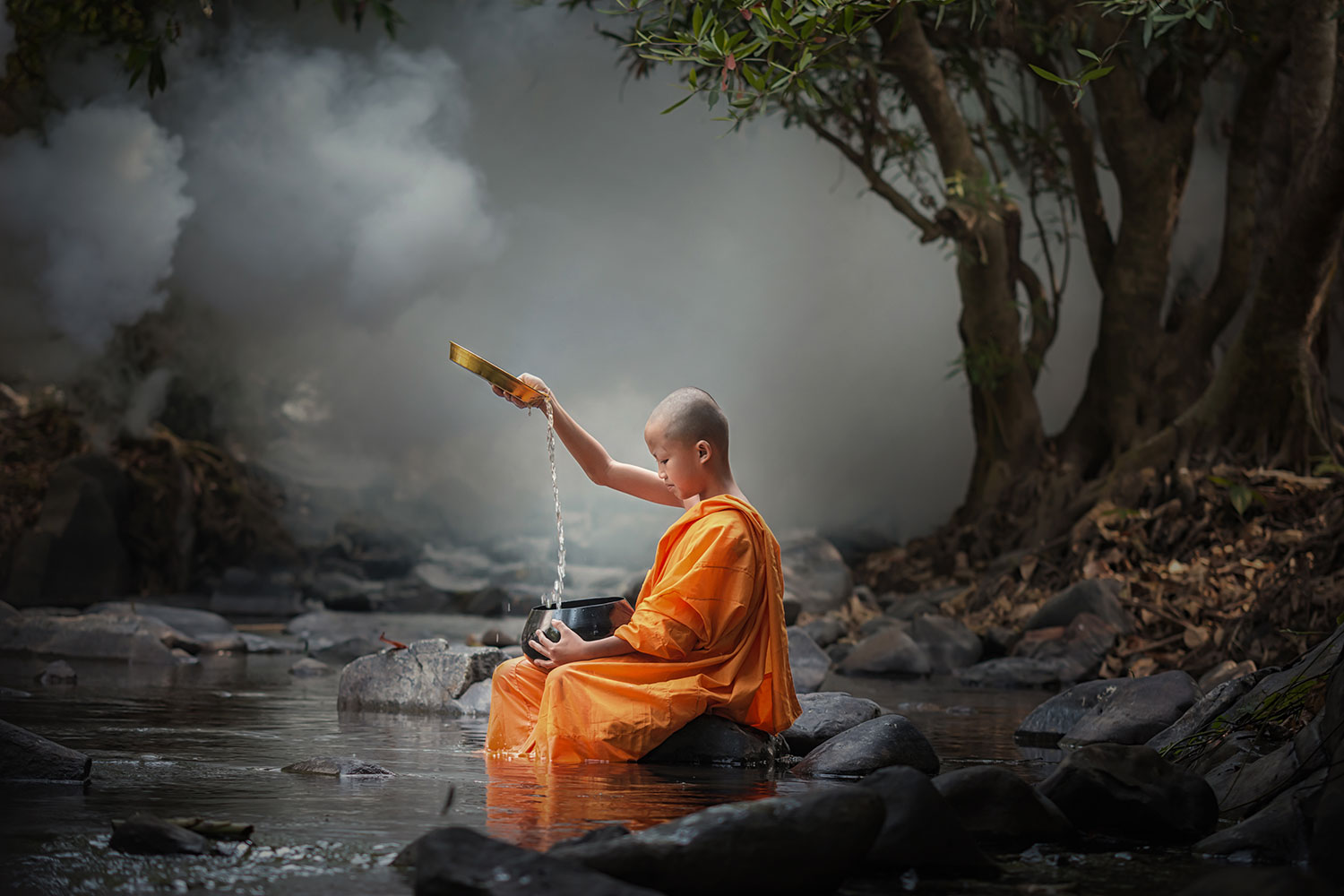
Meditation coach Emma Morrison is the go-to person for those…
Yoga is first and foremost a philosophy. And some of its roots can be found in the philosophy of Samkhya. Samkhya is Sanskrit and translates to “that which explains the whole.”
Samkhya has been called the theory while yoga is the practical application.
Samkhya specifies the number and nature of all constituents in the universe. This is also to say that Samkhya is a system of perfect knowledge.
Within the wisdom of Samkhya, there is a knowledge of the three Gunas.
What Are Gunas?
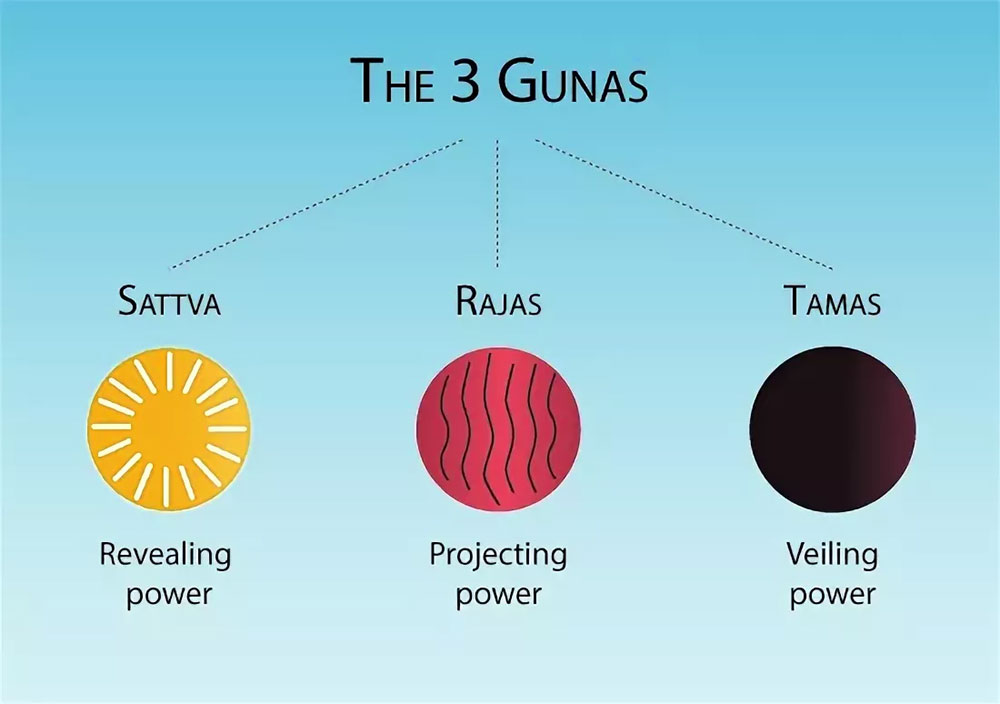
Guna means “quality” or “nature.” The Gunas are associated with all objects in the universe, both animate and inanimate. More importantly, the Gunas assert that all are born of nature.
Philosophically, the Gunas explain what the universe is made of.
It also explains how the universe came to be in the manifestations of mind and matter. For yoga practitioners, the awareness of Gunas is important. They can tell us whether we are moving forward in our practice and life.
The Three Gunas
The three Gunas are described as constantly being influx. They interact with one another in a playful state which is called Maya or illusion. These patterns of interplay define each Gunas essential quality. They can also influence one’s path or progress in life.
For yoga practitioners, Gunas can help to make better choices. These choices tend to be more balanced, peaceful, and harmonious. Both on and off the mat, the Gunas help guide us towards serenity. Cultivating one’s ability to identify and understand the Gunas is integral to one’s yoga practice.
The Gunas bring us closer to seeing the universal truth of oneness.
All three Gunas are always present. They are in all beings and objects around us but in varying amounts. Humans have the unique ability to consciously alter the levels of Gunas that manifest in our bodies and minds.
But the Gunas cannot be separated from oneself. Instead, they can be acted upon to either encourage an increase or decrease in energy. Through the interaction and influence of external objects, lifestyle practices, and thoughts, we can alter the Gunas inside of us.
Tamas
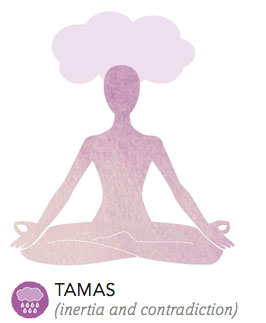
Tamas is a state of darkness. It governs inertia, inactivity, and materiality. Sometimes, it manifests from ignorance and deludes all beings from their spiritual truths.
Tamas conceals the presence of consciousness. It can cause dullness and ignorance through its power to obscure. The essence of tamas is heavy and dense. The Sanskrit synonym for tamas is “sthiti” which means “steady.” While it can supply a steadying influence in life, it is primarily immobilizing.
Tamas leads to inaction when action is required.
Each of us has experienced the binding power of tamas. We have all felt the appeal of lethargy, procrastination, and sleep. Below are some other tamasic qualities:
- Laziness
- Disgust
- Attachment
- Depression
- Helplessness
- Doubt
- Guilt
- Shame
- Boredom
- Addiction
- Hurt
- Sadness
- Apathy
- Confusion
- Grief
- Dependency
- Ignorance
Rajas
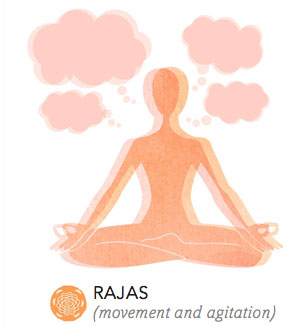
Rajas is a state of energy, action, change, and movement. The nature of rajas is of attraction, longing, and attachment. It strongly binds us to the fruits of our work. Most importantly, Rajas is the energy of change.
It is distinguished by passion, desire, effort, and pain. Our rajasic activity may cause us to move either towards sattva or tamas.
In this way, rajas may act positively or negatively.
Rajas is most often characterized as unsteady, agitated, and unhappy. It prompts change for change’s sake. Rajas can bring happiness by prompting the coupling of senses with objects. But it can also bind us to attachment, the fruits of our action, and sensory pleasures.
Below are some more rajasic qualities:
- Anger
- Euphoria
- Anxiety
- Fear
- Irritation
- Worry
- Restlessness
- Stress
- Courage
- Rumination
- Determination
- Chaos
Sattva
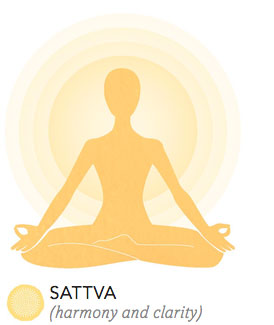
Sattva is a state of harmony, balance, joy, and intelligence. It reduces both rajas and tamas, thus making liberation possible. The essence of sattva is to act as a transparent pane of glass. You can allow light in to reveal the operations of the mind and in nature. This light is one’s conscious awareness.
Sattva is not enlightenment. But it unveils what is true and real.
It shows itself as beauty, balance, and inspiration. Sattva also promotes life, energy, health, and contentment.
Cultivating sattva means making choices that elevate awareness and foster unselfish joy. In this way, Sattva is the principle of yoga.
Below are other sattvic qualities:
- Delight
- Happiness
- Peace
- Wellness
- Freedom
- Love
- Compassion
- Equanimity
- Empathy
- Friendliness
- Focus
- Self-control
- Satisfaction
- Trust
- Fulfillment
- Calmness
- Bliss
- Cheerfulness
- Gratitude
- Fearlessness
- Selflessness
The Gunas at Work
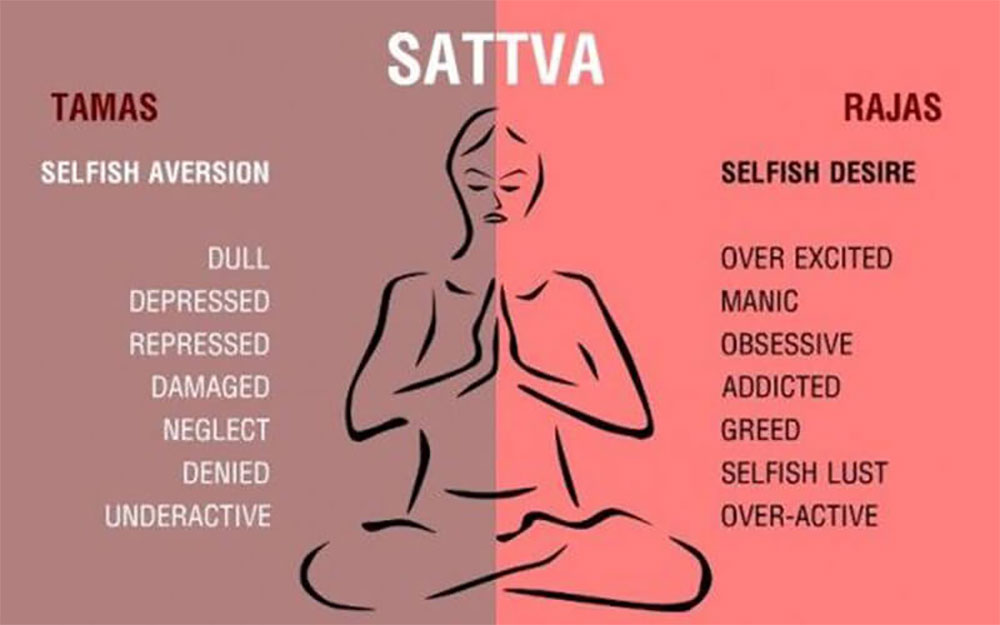
The three Gunas are constantly interacting with one another. We can discern hints from this interplay in various English phrases. For example, “innocent pleasure” is sattva-infused rajas. And “rabid addiction” is rajas-propelled tamas.
The Gunas are permanent in essence but their interactions are transitory.
The mind’s psychological qualities are similarly unstable and can fluctuate quickly.
The predominant Guna of the mind acts as a lens. It affects one’s perceptions and perspective of the world. Thus, if the mind is in rajas, one will experience world events as chaotic, confusing, and demanding. They will have a strong tendency to continue to react to events in this rajasic way.
Therefore, yogis work towards self-observation and discernment. This way, one can witness and not react to the activities of the Gunas. But one must also have the inner-strength and willpower to consciously shift their thoughts and actions. Turning away from tamas and rajas and towards sattvic balance gives us a purpose.
Still, the three Gunas can each be desirable for different yogic practices.
Sattva Guna is activated by meditation. It can turn the mind inwards to stillness and peace. Rajas is activated by pranayama and dynamic yoga asanas. The inertia of tamas is invaluable when one wants to sit still and meditate.
But one can become too attached to any of the Gunas. If one is attached to silence and lightness, it can be difficult to deal with the comings and goings of everyday life. If one’s rajas is out of balance, they can manifest in anger and combativeness. If one is overly tamasic, they may act lazy and careless.
Balance is the key to navigating the Gunas.
The Gunas in Life

Samkhya philosophers say that life exists to acquire the experience necessary to know the Self. The Gunas are meant to facilitate this spiritual journey. They can reveal, conceal, or stir us up all to draw us closer to Purusha, the knower.
But if you’re looking to reduce specific Gunas in your life, below are some tips to help you.
To reduce tamas, avoid tamasic foods, oversleeping, overeating, inactivity, passivity, and fearful situations. Tamasic foods include heavy meats and spoiled foods that are chemically treated, processed, or refined.
To reduce rajas, avoid rajasic foods, over-exercising, overwork, loud music, excessive thinking, and consuming an excessive amount of material goods. Rajasic foods include fried foods, spicy foods, and stimulants.
To increase sattva, reduce both rajas and tamas in your life. Eat sattvic foods and enjoy activities and environments that produce joy and positive thoughts. Sattvic foods include whole grains, legumes, fresh fruit, and vegetables.
All yogic practices are developed to create sattva in the mind and body. Thus, practicing yoga and leading a yogic lifestyle strongly cultivates one’s sattva.
But all Gunas can create attachment, thus binding oneself to one’s ego.
While the yogi goal is to cultivate sattva, the ultimate goal is to transcend the misidentification of self within the Gunas.
One can and should strive to be unattached to both the good and the bad.
Final Thoughts on the Gunas
Yoga teaches us many things. But perhaps the greatest lesson is to explore the true nature of the mind. In this exploration, one will realize that everything that arises from the mind is an expression of consciousness. The mind itself exists within consciousness.
Without this understanding, yoga practitioners may continue into Maya or illusion. Through yoga, one can develop the mind as a whole. Doing so will help one acquire balance within the manifestations and expressions of the three Gunas.
Understanding the Gunas provides a practical basis for our self-awareness. This self-discovery will help assist one’s yoga practice.
By identifying what is tamas, rajas, and sattvic in one’s life, they can heighten their awareness. This awareness can lead to better decision-making in the future. These decisions will take into account what is needed and what can be let go of.
If you find yourself particularly attached to one Guna, try exploring why. You may find insights within your consciousness that you did not previously know. In this way, the Gunas ultimately encourage curiosity. They are not the end-all-be-all, but rather a tool for our spiritual journey.
Remember that the essence of Gunas is permanent but their interactions are transitory.
This will help you remain in the present moment and address the needs of now. It will alleviate any pressure you may feel to uphold the Gunas. Just as our mind fluctuates and changes, so do the Gunas. In this way, the Gunas also remind us that everything is temporary. What may feel difficult now will eventually pass.
But if you find yourself in a hard position, try assessing what Gunas are at work. Perhaps there are ways to combat what is difficult. Even just reflecting on what is difficult can provide insights into our practice.
What is difficult for us may come up again and again. So let the Gunas be your tools to uncover what is blocking you.
Never forget that you can alter the Gunas. If you know what you need, you can change your circumstances. You have the power to transform.
What's Your Reaction?
Meditation coach Emma Morrison is the go-to person for those living in Salt Lake City, Utah, who need to release stress and tension or simply dive deeper into their meditation practice. In her writing, you’ll receive useful information on how to live a more fulfilling life.






